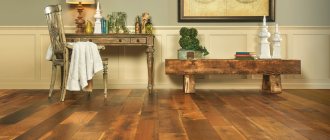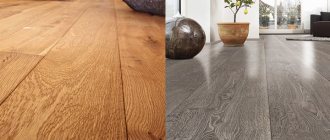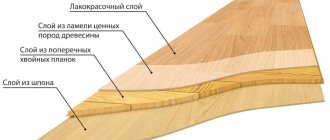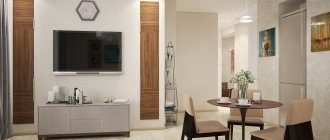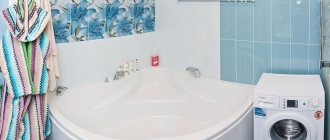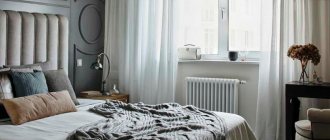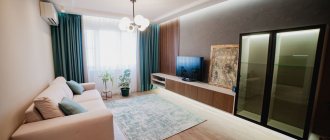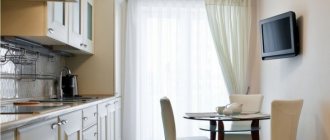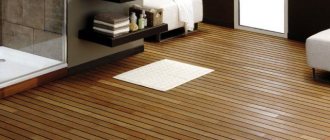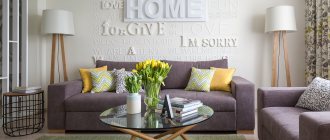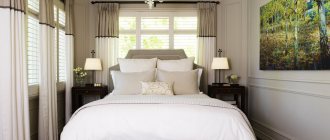It may seem that a parquet board in the kitchen is not the most suitable option, but only for those who know nothing about its variety with increased resistance to mechanical damage and moisture.
Linoleum in the kitchen is familiar and cheap, but hardly practical, much less status-worthy. Tile? Better. But if you think about how unpleasantly cold and even repulsive a kitchen floor tiled in winter will be, the desire to make a choice in favor of this material disappears. A properly selected parquet board is the optimal solution and here’s why.
Advantages and disadvantages
To produce this type of flooring material, beech, oak, ash, jatob, and other wood species are used. This type of flooring pleases with its beauty and attractiveness. There are disadvantages and advantages of application.
There is always the opportunity to choose a suitable interior solution
Pros:
- The parquet board in the kitchen looks noble, attractive, and interesting. The buyer can choose the shade, pattern, shape of the picture;
- Variety of materials. The optimal variation for a room with high humidity and difficult conditions is oak. But you can choose to prefer other types of wood: beech, ash, maple, walnut;
- Hypoallergenic. Natural wood does not accumulate dust particles. Caring for it is simple and comfortable;
- Long service life. With proper care and use, natural wood will serve its owner for up to 25 years. Specifications may vary depending on the type of wood used for the material.
Parquet boards are expensive
Cons:
- Price. The material has a high price. It can reach from 14 to 55 dollars per 1 square meter;
- Tendency to damage. Especially noticeable in soft wood species;
- Difficulty of care. To maintain its attractiveness, the surface must be sanded every 10 years.
The use of natural wood in the interior will be reasonable if the advantages of the material for the home owner outweigh the disadvantages. The flooring looks impressive with any interior design.
What is the difference between moisture-resistant parquet and water-resistant?
The production of moisture-resistant parquet is based on the use of a specialized HDF board treated with a water repellent - a substance responsible for water-repellent properties. It is this material that makes it possible to easily recognize moisture-resistant parquet - at the cut site, the HDF sheet has a green pigment.
To avoid becoming a victim of counterfeiters, when purchasing moisture-resistant parquet, in addition to the color difference of the HDF board, you should focus on the manufacturer’s rating. All information regarding the company that produces parquet flooring is indicated on the packaging.
The HDF baseboard is manufactured using a rigid compression molding process, which gives it water-repellent and wear-resistant characteristics. In addition to this, moisture-resistant parquet based on HDF boards prevents the occurrence of fungus and mold. This is especially valuable for using it in kitchens, where the percentage of air humidity will be high.
A moisture-resistant version of parquet flooring can resist the effects of dampness and humidity. However, prolonged contact with water is detrimental to it. If, for example, a battery leak occurs, the parquet will be damaged.
When choosing a moisture-resistant parquet, you should focus on the density of the HDF board and the swelling coefficient. The first parameter should be as high as possible, and the second – no more than 18%.
What does the price depend on?
When deciding to install a material such as parquet boards on the floor in the kitchen, price remains an important issue.
Its formation is influenced by several parameters:
- Manufacturer;
- Wood species;
- Laying method;
- Number of lanes.
Parquet made from exotic species, red, is more expensive. Two- and three-strip planks cost less than single-slice planks. The quality will be the same in both situations.
A little about installation
Before you start laying the parquet board, after purchasing it, you need to leave the material for a couple of days in the room where the installation will take place. He must “get used” to the conditions. The base must be well leveled.
Installation should still be done by professionals; this will increase the service life of the coating, save time, and possibly money. The board should be laid perpendicular to the window so that the joints are less noticeable.
Parquet on the floor or wall?
People's reviews show mixed opinions about such material as parquet boards in the kitchen. Some try to put the material on the floor of the room, others - on the wall. The popularity of such design solutions is based on the variety of parquet processing options:
- Toning;
- Brushing;
- Staining;
- Decoration with microbevels;
- Thermal impact.
Any parquet board on a kitchen wall can be laid vertically, horizontally, or diagonally. In this case, the material is laid either entirely over the surface or in separate areas.
Solid board for the kitchen
Natural materials for decorating your home are a sign of good taste and care for loved ones. After all, you have chosen luxurious, warm and environmentally friendly products. Wood, which is used for finishing walls and floors, occupies a special place among natural materials.
Advantages of solid boards
Solid boards are an excellent choice for durable and reliable floors in residential areas. It consists of solid tiles of boards made of natural wood, which are connected to each other in a tongue-and-groove manner. In essence, this is massive parquet of large sizes.
The board is made from solid parts of wood, it is environmentally friendly, has a natural structure and excellent texture. The dimensions of the coating allow you to make any interior original and luxurious. Solid wood boards will delight you with their durability and resistance to external adverse influences.
Lay the massive board on a previously prepared and perfectly flat surface.
How to choose a wood type?
It is important to choose the right type of wood for parquet. The most popular options:
- Oak. The wood is distinguished by its noble pattern and beauty. There are about two hundred shades - light and dark. Durable and strong dies do not fade during use, but only darken a little. Other qualities are moisture resistance and resistance to mechanical damage;
- Birch. It becomes a soft wood material and is pre-treated before use. Birch parquet always has a light shade and looks like plywood;
- Larch. The main advantages of this parquet are moisture resistance and antiseptic properties;
- Ash. It has a beautiful pattern, dense texture and strength;
- Bamboo. Suitable for those people who want to save money on flooring. Main qualities: affordable price and good wear resistance.
When answering the question whether it is possible to install parquet boards in the kitchen, it is important to take into account the characteristics of the wood species. Its properties include moisture resistance, strength, and resistance to external influences.
Composition of parquet flooring
Parquet panels are made of three layers using natural wood. They are glued together in a cross pattern. To create an impact-resistant material, the boards are compressed under pressure, creating a single piece without seams.
Each layer of parquet panel has its own properties:
- the top layer of the material is made of valuable wood, its thickness is within 4 mm;
- the middle layer consists of coniferous wood - the layer is placed perpendicular to the tiles of the first layer;
- the last layer is made from a sheet of plywood 2 mm thick.
Note! The parquet board for the kitchen should be quite thick. Its wear resistance and strength, as well as its further service life, depend on this parameter.
Installation of parquet boards
How to protect parquet boards on a kitchen floor?
It is important for people to keep their flooring in good condition. Therefore, you need to protect the planks and regularly treat them with detergents. You need to pay attention to products without toxic substances in their composition. The strengthening effect is also an important aspect.
The product is applied to the floor surface for 10 minutes. Then the parquet can be wiped down. As a result, the wood coating will begin to shine. Although there are pros and cons to using parquet flooring in a kitchen, this protection process is required for all wood species.
Comments: 10
Architect-designer Diana Mironova
Absolutely practical. If you are really, really afraid of leaks, place a row of tiles under the kitchen unit - they won’t be visible, and the anxiety will subside) And in everyday life, we don’t do anything that would harm the parquet board. My kitchen is generally on laminate and nothing bad has happened to it or to me. The water is wiped off, the cups fall and do not break (almost) but still looks better than tile patches)
- Like
- Save
ppg87
- Likes: 1
- Save
Related discussions
sliding interior doors - pros and cons.
Winter garden in an apartment: pros and cons
Linoleum - pros and cons?
Sink by the window in the kitchen. For or against?
Zoya Kasyanova
Tiles are more practical, after all, there are two children, is it worth the risk? Second option.
- Likes: 1
- Save
- Like
- Save
Studio of design, furniture and equipment “APlus”
Parquet boards in the kitchen, especially any cork covering, are impractical. Based on operating experience. Indentations from chairs remain on any board. In the kitchen, rearranging and moving chairs occurs much more often than in rooms. Damage and scratches occur more frequently. The cork becomes dirty and is pulled out. Board – dents, scratches. Better than any porcelain tile.
- Like | 4
- Save
Svetlana Gavrilova
Also for the second option (including the second option for the layout, the border along the doorway is clear).
But it is very important that the tile is warm. That is, not only a warm floor, but also prepare the base below. I noticed that if the tiles are laid directly on a concrete base, then the tiles are colder than if they are laid on a floating screed with stone wool or expanded clay underneath.
- Likes: 1
- Save
Fine Floor
Consider quartz vinyl tiles. And it is perfect for the kitchen area. Tactilely pleasant)
- Like
- Save
Fedor Telman
Laying parquet boards in the kitchen will only create difficulties for yourself. You will have to pay a lot of extra attention to the floor. This kind of floor does not like falling objects, which is very likely for this room, and even more so any kind of liquids, drops of oil and fat, etc. If you really want wood under your feet in the kitchen, then it is better to make a parquet board starting from the dining area. In your case, it’s generally easier to start with the living room area, as shown in the second case. In addition, if its color is different from the tile, visual zoning will also apply. But if you want to lay parquet boards everywhere, then it’s worth studying its design features and decorative treatments; they write a lot about this on the Internet. It is available about the features of using and choosing parquet boards here – https://master-pola.ru/parketnaya-doska-na-kuxne/
- Like
- Save
Antonina
I completely disagree with the statement about the impracticality of cork in the kitchen, but only if it is an adhesive cork and not a prefabricated one. Nothing breaks, you don’t have to worry about leaks, it’s pleasant for your feet. Tested over the years both on myself and on customers. The only thing is that the cork has a unique look, of course, if you like it, buy it and glue it on
Is there parquet everywhere or should it be combined with tiles?
Design solutions for laying parquet are relevant for owners of houses and apartments. There are classic and modernized variations. For example, you can completely lay out the floor or wall with parquet, or combine the material with tiles.
Ceramic tiles and parquet boards in the kitchen look noble and attractive. They can be done in plain or contrasting colors.
Design solutions
When choosing a parquet board as a finishing material for the kitchen, take into account the requirements for its practicality. In such a room, no matter how carefully it is used, dirt, crumbs, and damage from mechanical influences always appear.
Modern processing methods help create glossy parquet boards in both white and black shades, but on such a surface any damage will remain visible and difficult to disguise.
Based on this, design project specialists recommend choosing a material with a matte surface, decorating the kitchen in a white and brown shade, using brushed models and color variations. Wood looks great without tinting, demonstrating its original texture. Natural colors, changes in brown and gray colors will make it easier to choose door designs, baseboards, highlight special features of furniture, bring brightness to the design elements into the room, and disguise accidental damage.
Which is better: parquet boards, laminate or solid wood on the kitchen floor?
When choosing a floor covering, it is necessary to take into account technical characteristics, functionality and ease of maintenance. For example, laminate costs less and is more resistant to mechanical stress.
In terms of aesthetics, parquet takes the lead. But its cost is much higher. However, parquet boards in the kitchen and hallway look perfect. The final decision always remains with the owner of the house or apartment.
Positive properties
To lay parquet in the kitchen, you should first find out about the properties of the material. The flooring must be durable and meet the specific requirements for this room.
Advantages of parquet:
- it goes harmoniously with a kitchen decorated in any style;
- meets environmental requirements;
- made from natural material;
- easy to install with glue or using locking connections;
- suitable for creating a “warm floor”;
- excellent sound insulator;
- is not subject to deformation after installation;
- features a varied color palette;
- during restoration, damaged areas can be restored;
- has a protective coating;
- strong and durable.
Combined flooring in the kitchen
But parquet flooring for the kitchen also has negative aspects:
- the cost is much higher than other coatings;
- special formulations are required for care;
- it is impossible to create a unique drawing;
- the coating does not like high humidity; when left in water for a long time, the boards swell and become deformed.
Reviews of parquet flooring in the kitchen
Before laying the selected type of parquet, you need to read the opinions of people who have already installed such flooring. You can find reviews on construction forums, manufacturers’ websites, and online stores. Moreover, some people put the material on the floor, others make an apron in the kitchen from parquet boards or combine it with tiles.
“The parquet board in my kitchen suffers only because of the vandal children who hit it with everything while I’m cooking. It doesn’t suffer from the cooking itself, and it’s easy to clean up. but now I would put block parquet everywhere with the hope of being able to sand it. a tree is a tree. and we spend a lot of time in the kitchen. we looked at the array, but it seems to be more capricious.”
“Our apartment has completely parquet boards in the living room-kitchen; out of principle, I decided not to tile anywhere in the apartment, even in the hallway. While a little time has passed since the completion of the repair, I can’t say about the operation, but so far everything is fine. We get used to using a washing vacuum cleaner to wash away food stains left by children.”
“I have piece parquet in my kitchen. I was very pleased; when I was doing the repairs, everyone dissuaded me and convinced me that it was not practical. After some time, I’m very glad that I didn’t stand my ground and laid parquet flooring; walking on it barefoot is a great pleasure. Easy to clean"
Disadvantages of using moisture-resistant parquet
- When choosing high-quality moisture-resistant parquet, the buyer should not focus on the budget option. The cost per square meter of coating from a reputable manufacturer will be more expensive than the alternative option - tiles or linoleum. However, this minus can be considered as a long-term financial investment - the guaranteed service life of a good moisture-resistant coating of class 32-33 is 12-15 years.
- Moisture-resistant parquet is not recommended for use in homes for seasonal use. Due to freezing and a high level of general dampness in winter, even the highest quality parquet can absorb moisture and become deformed from the inside.
- When laying moisture-resistant parquet, it is necessary to have a waterproofing layer between the subfloor (concrete) and the slab itself. Otherwise, the parquet may absorb condensation from cement or concrete and quickly become unusable.
- To avoid the penetration of hidden moisture, laying moisture-resistant parquet is recommended in those domestic or office premises where the humidity level will not exceed 65%.
Moisture-resistant coatings are resistant not only to water ingress. Aggressive liquids containing alkali or chlorine will not harm parquet floors and can therefore be used to remove dirt.
